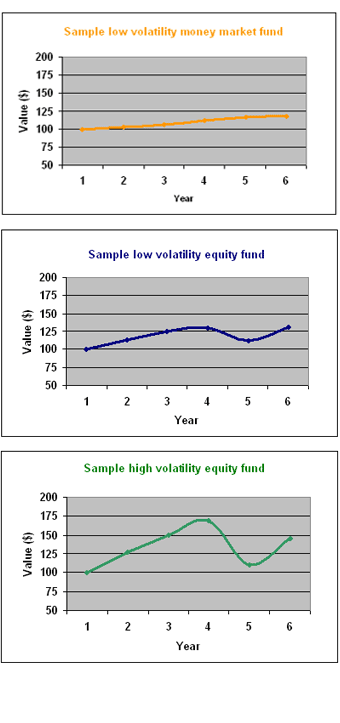 | |
| No investment is entirely risk-free. It's important to understand the risks associated with your investments and choose investments that are within your comfort level. Risk takes different forms: Diversification risk –you can't avoid risk when it comes to retirement savings without restricting your opportunity for higher returns. That's why diversification is important. By spreading your risk across several different asset classes and funds, you limit your exposure in any one area. Volatility risk – volatility risk is linked to investing in market-based funds. There are no guarantees with these types of investments. Their performance can go up and down – that's volatility. Of course, there are different degrees of volatility. A bond fund has moderate volatility while a foreign equity fund has a more severe volatility. The charts to the right show you three different volatility scenarios. When analyzing volatility and market-based funds, consider:
2. Risk of losing an opportunity for gain – by avoiding market-based funds, you risk missing out on the potentially higher rewards of market-based funds. 3. Risk of falling short of your retirement goals – the possibility that interest-bearing investments will not grow to the required amount for your retirement. Inflation risk – there is a risk that the rate of return on your investments won't keep pace with inflation. This is especially true if you invest in guaranteed investments when interest rates are low. For example, you receive a 6% rate of return but inflation was 3%. You really only gained 3% on your investment. This is a risk when it comes to saving for retirement. Inflation can eat away at the value of your retirement savings. Interest rate risk – when buying a guaranteed interest vehicle (referred to as a guaranteed interest certificate or account, GIC or GIA, respectively), you are locking into one fixed return for the term of the investment. If interest rates increase significantly while you're invested in a lower interest rate, you can withdraw assets from a GIA and reinvest in a higher interest rate GIA. However, there may be depreciation or a market value adjustment. Alternatively, you can wait until the GIA matures but the opportunity may be gone. |  |
    |